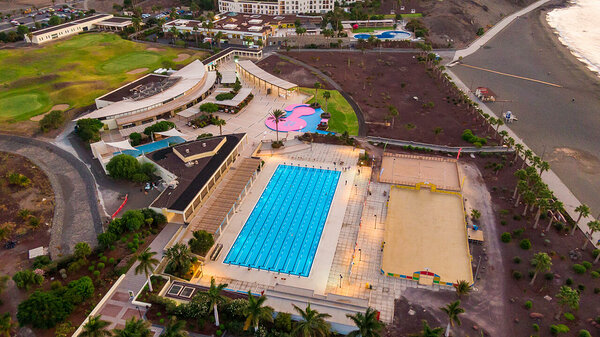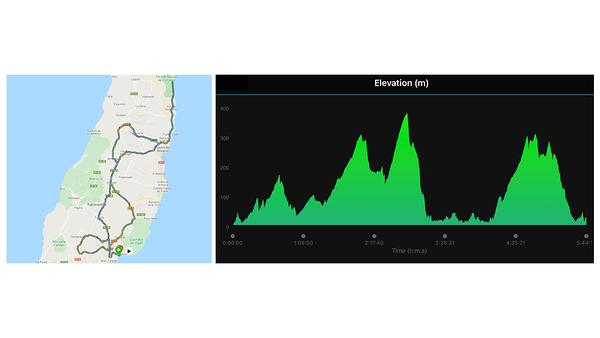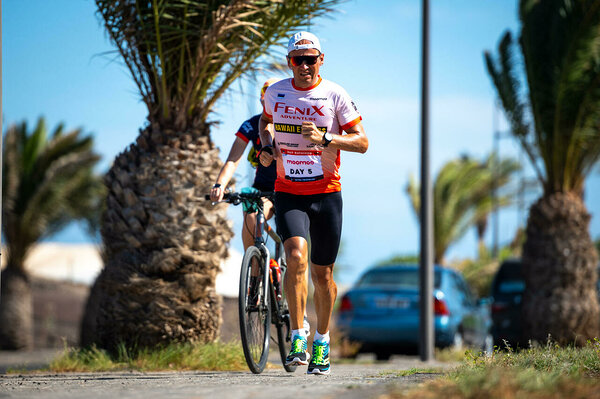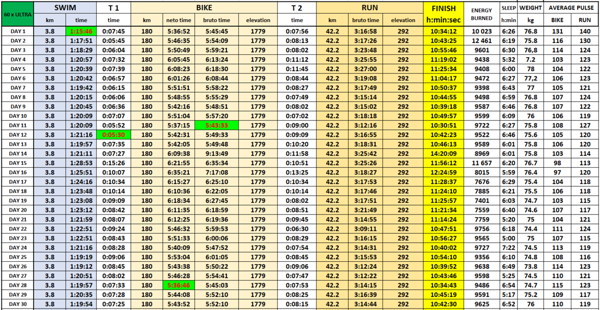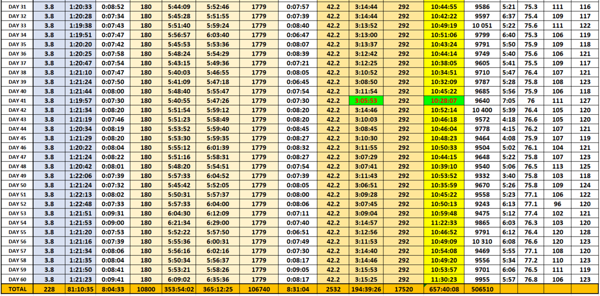From October 5 until December 3 I will organise myself a 60x day-by-day format ultra triathlon in Fuerteventura (the Canary Island). That means 60 consecutive days of 3.8 km swimming, 180 km biking and 42.2 km running. That means in 60 days I will swim 228 km, bike 10 800 km and run 2532 km.
In 2019, I organized a 40-times ultratriathlon in the same place (see more here). On November 6, I finished the challenge with a time of 444:21:35, which is an unofficial world record in terms of speed - it took me an average of 11 hours and 6 minutes to do one full-length triathlon.
In terms of distance, the world record belongs to the Frenchman Ludovic Chorgnon, who successfully finished the 41-time ultratriathlon in 2015 with a time of 533:41:00.
One year earlier (2018), I organized myself a 20-times ultratriathlon in the same place (see more here). On October 12, I finished the challenge with a time of 238:52:34, which is also an unofficial world record. The record (241: 36:45) set in the IUTA World Cup race belongs to my good firend Norbert Lüftenegger, with whom I meet again and again in ultra competitions.
Bike course route and elevation
After the cycling awaits me a 42,2 km run in extreme conditions as the heat reaches its peak around 3 PM. That means that the first half marathon has to be run in the hottest weather Fuerteventura has to offer. The running route has also a lot of ascending and descending meters (292 m) that are characteristical to the landscape.
Photo: Jakob Meier
60-times ultratriathlon: times and statistics (updated daily)
This time I use electronic timing. You can find the live results HERE.
From the table below you can see how much time I spend in the water, on the bike, on the run course and in transition zones every day, how much I sleep at night and what my heart rates are according to my Garmin devices in different disciplines.
My main goals
Since I have already successfully completed 40 times ultra-triathlon, I will not do anything new in terms of distance until 41 days. Therefore, the first 40 days are mentally more difficult. For example, during the 40-times ultratriathlon in 2019, I experienced how it suddenly became much easier mentally on the 21st day, because I had already done the 20-times ultratriathlon in 2018 From day 21, I could tell myself that I had pushed my boundaries further.
To keep the mind alert and stay motivated, my goal is to be faster than during 40-times in 2019.
During the 40-times ultratriathlon, I also set myself the goal to be faster than in 2018. I succeeded. First 20 days of the 40-day challenge took me 225:32:41, which was more than 13 hours faster than in 2018, when I finished with 238:52:34.
The goals I am pursuing this time are, in order of importance:
To finish.
To get the average time taken to complete one full-length triathlon under 11 hours, which means he wants to finish the challenge in less than 660 hours.
To finish all 60 full-length triathlons in less than 12 hours. For example, in 40 times ultra-triathlon, this goal was achieved 39 times out of 40. On the last (40th) day, my finishing time was 12 hours and 2 seconds.
Like 20- and 40-times ultratriathlon, my goal is to run all 60 marathons in less than four hours.
To get the average time of 60 marathons to be less than 3 hours 25 minutes, i.e. the goal is to beat the time of the 40-day challenge.
To get the average time for cycling less than 6 hours. During the 40-day challenge, i was 6 hours and 8 minutes.
The main rules
The following distances must be covered each day: swim 3.8 km, bike 180 km, run 42.2 km. The tracks are measured.
Time is continuous - time starts at the beginning of the swim and stops at the end of the marathon.
The use of wetsuit is allowed (as it is allowed in IUTA World Cup competitions).
Drafting on the bike is not allowed.
The use of unauthorized persons and equipment to move forward on the run course is prohibited.
One full-length triathlon must be completed within 24 hours.
The rules of fair and clean sport must be followed.
The bike start needs to be near its finish. It would be very easy to start the challenge every day from the north and move in a favorable wind and end in the south :).
A frequently asked questions (FAQ)
Here I answer the questions I have been asked repeatedly. If you have any questions, feel free to let me know on my FB or Instagram.
Why am I doing this?
The shortest answer is that I just love it. Sport is my passion and lifestyle. I want to see what my body and mental strength are capable of. I believe that the human body is designed to move, and with proper preparation, the body is able to exercise from morning to night for days, weeks, and months in a row. I am motivated and inspired by development and getting to know the functioning of my body and mind. That's why I don't like to do the same things just in terms of passing them (without setting time goals) and collecting, but my goal is to do better and/or go further than before.
Am I not ruining my health with that?
I wouldn't do that if I thought it would endanger my health. On the contrary, I believe that it guarantees me good health, mobility and viability at an advanced age. Today I have been doing ultratriathlon for 7,5 years and ultra running for 10 years. I have been training with large volumes for 20 years. During this time, I have never been injured and I have not had any problems with the functioning of joints, tendons or muscles. For me, that’s a long enough time. From the moment I started practicing ultra-triathlon, I have been constantly monitoring my blood indicators (I have given about 60 blood tests in seven years) and these analyzes have been in order. An important argument for me is also that in every ultra-competition I can see with my own eyes how men and women of very high age successfully do ultrasports.
I don't think I can convince you of that. That is not my goal either. We just have to wait a couple of decades and see if I was right or not :).
Why am I doing this challenge in Fuerteventura?
There are several reasons. First of all, of course, good roads and a great traffic culture, where the rider can feel safe in traffic. On the other hand, a good climate. Fuerteventura weather is warm and day and night temperatures do not differ much. For example, if the temperature outside is 28 degrees during the day, it is at 20 degrees at night. In addition, the difference between daylight and night time is relatively small all year round. For example, even in the middle of winter there is about ten hours of daylight.
Thirdly, because I have organized two of my previous challenges here, and by doing it again in the same place, I know exactly what and how needs to be done. In this way, I can take into account the pros and cons of the previous challenges. For example, the challenge of 2019 was much easier for both me and the team, because from 2018 everything was already familiar and known..
Finally, in Fuertevenutra, I can do my challenege in the autumn (when the weather in Estonia is already cold and there is a lot of dark time). By doing this in the fall, it gives me the opportunity to take part in the IUTA World Cup ultratriathlon in the spring and summer.
Why am I organizing this challenge for myself?
The reason is simple. As a competition, such long ultra triathlons have never been organized and it is unlikely that it will ever be held as a competition, not to mention such a demanding place as Fuerteventura. There just aren't enough participants to organize it, let alone financial costs. So far, the 30-times ultratriathlon is the longest that is organized as a competition.
What is the world record?
The current world record belongs to Ludovic Chorgnon, who completed 41 full distance triathlons in 41 consecutive days in 2015. The American James Lawrence did recently 101 and although it was a remarkable achievement, unfortunately his challenge is not comparable, because he did not follow the generally accepted rules of the full-length triathlon format (read more here).
Why did I choose Playitas Resort?
Those who have visited the Playitas resort know that it is a sportsman's paradise. Starting with a 50-meter outdoor pool, all kinds of other sports facilities, a cycling center where all your bike worries can be solved, friendly and helpful staff, and of course a breakfast and dinner buffet with a rich selection of quality and healthy food. It is a great relief if during the challenge none of us have to worry about cooking.
Why am I swimming in a pool and not in the ocean?
The key word is safety. Although it is warm in Fuerteventura, for some reason the ocean water is cold (probably below 20 degrees). From the second day of the challenge, the body is tired and deficient in energy and the muscles are sore, so the 25-degree pool water will feel pretty cold, not to mention the much colder ocean. Moreover, I know nothing about how the ocean, currents, high tides and low tides and how the strong winds inherent in Fuerteventura affect its behavior. That is why swimming in the ocean carries many risks that are unknown to me, not to mention its organizational issues and the costs involved.
Practically most of the swimming part of ultratriathlon competitions takes place in the pool. This is probably primarily for safety reasons. Sometimes (mainly shorter ones) in the lake.
Why do I wear a wetsuit in the pool?
In exhausted conditions, the body behaves and experiences temperatures differently. Therefore, swimming on the first day is quite different from swimming on the second, third, etc. days. On the first day it is easy to keep your body warm by swimming. Everything changes from the second day, when the production of body heat in exhausted conditions is no longer so easy. Therefore, the wetsuits are used in ultratriathlon competitions from the very first stage (i.e. double ultratriathlon), regardless of the water temperature in the pool.
Why a 60-times ultratriathlon, not a 70-, 80- or 100-times, for example?
I set goals by listening to my inner voice - it rarely makes a mistake. At the same time I also have to consider what time and financial resources I have. It is important to me that it fits into my family life. I always talk to my spouse in advance about the plans and make it clear if, when and how to organize the new challenge so that it doesn't turn our family life upside down. We have a cute little son Rasmus and his well-being and upbringing is our highest priority in life.
In case of such enormous challenges, setting the right goal is crucial. At the beginning I could double my challenges in terms of distance - for example, I went from 5-times to 10-times, then to 20-times and then to 40-times ultratriathlon. However, this exponential growth of goals cannot last very long. Jumping from 40 to 80 or 100 would have been risky, given that my goal is not just to finish, but to do it as soon as possible. It is worth remembering here that the purpose of this challenge is to test the limits of my abilities, not to feed my ego or to impress others and seek their approval.
Will I stop at 60 even if all is well on the last day and could I continue?
For example, people said during and after my 40-day challenge that I should have gone further to set a world record for most full-length triathlons in consecutive days in addition to my fastest time. Such a statement shows well that the questioner does not have any idea or experience of how the human brain works during such physical and mental challenges. Ultrasport is the best example of how important it is to have a goal. "Let's start quietly and see where we end up" doesn't work in situations like this. The brain must know exactly (according to objectively measurable criteria) where the end finish line is. This is necessary in order to be able to persuade your brain not to give up during physically and / or mentally difficult moments. And there are many of those moments. In other words, and figuratively speaking, before each challenge, I make a deal with myself in my head where the finish line will be. It is nessesary in difficult moments when the brain can tell the body how much more it has to manage. However, it is just as important to respect this agreement on the other hand, i.e. the principle is that the rules are not changed during the game. If you do not honor the agreement, the next agreement may not be reached in the future, if you understand what I mean.
My previous two similar challenges seem to be a good example of how the brain tells the body how much it has to endure, not the other way around. Namely, during both the 20-day and 40-day challenge, the last days were the most difficult in terms of physique, but the body still managed to the end. At the moment, I can only explain the difficulty of the last days by the fact that the body knew that the finish was close. Therefore, it began to show fatigue. It will be interesting to see if this happens again - that the last few days will be difficult in terms of muscle condition.
Do I go through exactly the same paths every day for 60 days? Why?
That is the plan. However, I must also be prepared for the unexpected. 60 days is a long time and may include road works or the partial closure of roads for other reasons. For example, during my 40-day challenge (somewhere around day 25), the 25 km of my bike course was closed for filming. So I had to change the bike course a bit that day.
Going through the same route every day provides a good opportunity to compare and analyze data later, however, with a reservation that the weather is not the same every day.
Lastly, I would like to point out that it is easier to organize and avoid mistakes if the course stays the same.
What does my day look like during the challenge?
I will wake up at 6.00. Then I eat. Swimming starts from 7.30 and lasts until 8.50. Then begins the cycling and lasts about 6 hours. Then it is time for a marathon run, which lasts somewhere about 3.5 hours. Then I eat, take a shower and change clothes. Then it's time to talk to my family on the phone. Then I have a proper dinner. Then about an hour of massage, after which I eat again :). I go to bed around 10 p.m. At night, my body usually wakes me up 1-2 times to get food. Note that most of the energy consumed is eaten back outside the sporting time (including at night).
This part will continue ... We will complete this part over time.
